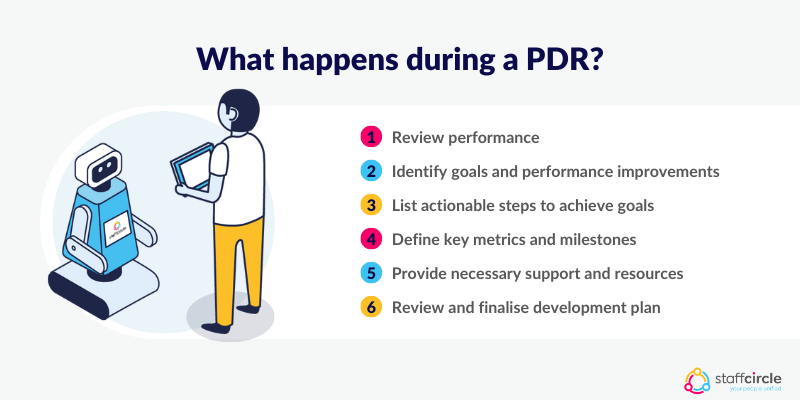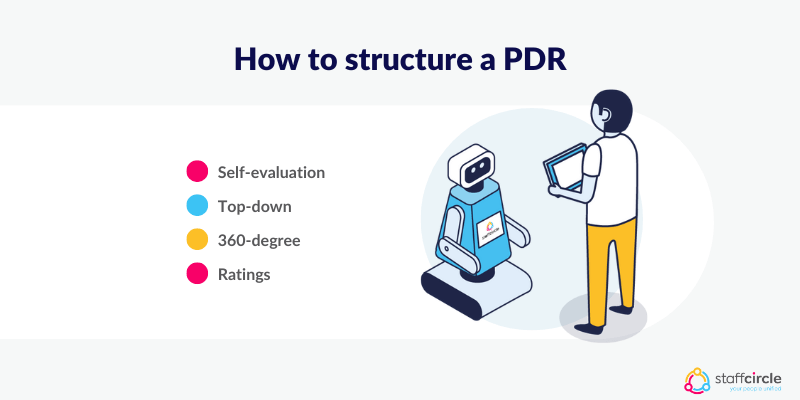What is a PDR? Performance development reviews (PDRs) are an essential part of the performance management cycle. They allow managers to assess their progress towards completing core goals, as well as help them plan future goals while developing the necessary skills.
This guide will explain the main elements of a PDR you need to know so you can implement them as part of your overall performance management strategy.
How does the PDR process work?
The Performance Development Review process works by bringing the employee’s level of development in line with the company’s broader vision and strategy. The process can help HR teams to better approach how they hire, promote, and generally motivate their employees.
They are also an opportunity for employees to seek clarification from line managers about their expectations for their role and responsibilities, assessing prior performance to establish new development goals. This can help ensure:
- Strong alignment between personal and professional goals with the corporate goals of the organisation.
- Career progression opportunities and prospects for promotion.
- Remuneration decisions for instance bonus payments or salary raise.
- A general understanding of what training and development will help them to succeed in their role.
What is the purpose of a PDR?
A solid Performance Development Review should be about more than just fine-tuning employee performance and correcting shortcomings. A PDR discussion should be designed to inspire confidence and motivation so that the employee becomes a committed member of the company determined to deliver his or her A-game.
The article from Gallup discussing how to create performance reviews that inspire employees, observes:
“Gallup recommends reframing these meetings from “performance reviews” to “progress reviews.” A progress review should be aimed at continual improvement and development. The best managers recognize their employees’ achievements and help them understand how they can improve in the future. Effective progress reviews should allow for conversation about successes, not just opportunities for feedback.”
This extends beyond simply inspiring employees and helps create employees who are fully aligned with the company’s core mission and values.
What happens in a PDR?
The Performance Development Review process is simple. There are six main steps to the process you need to go through, which we’ll review in more detail now.
These steps are:
1. Review the performance
Managers and the employees in question should first review the performance from the previous period of time. If the reviews are monthly or quarterly, then take the latest review as the starting point for this assessment.
List down what went well and what didn’t, with any evidence supporting the data included in the report. Managers can also use 360-degree feedback software to gather additional information about performance from an employee’s peers and colleagues.
2. Identify goals and other performance-related areas for improvement
The review stage should highlight those areas where the employee has room for improvement. From this retrospective review, goals can be set for the next period of time moving forward.
One to three core development goals is typical, which need to be well-structured so that they can be relatively easily accomplished. Using the SMART goals framework can help keep these on point: that is, making goals specific, measurable, achievable, realistic, and timely.

3. List actionable steps to achieve those goals
Goals require a plan of action in order to accomplish them, whether this is meeting new quotas or developing new skills and abilities. As part of a Performance Development Review, these actionable steps need to be noted and tracked over time to make sure the employee is living up to expectations.
Some examples of activities and steps employees might include are:
- Working closely with a coach or mentor
- Taking on a training program
- Volunteering for special projects and assignments
- Attending workshops and seminars
4. Define key metrics and milestones to measure success
The goals and objectives that emerge from a review of prior performance need to be easily measured over time so that both the employee and their manager can take action should something go wrong. This means choosing specific metrics to measure through performance management tools in real-time.
These can be included as Key Performance Indicators (KPIs) objectives which are capable of being adjusted when necessary, with new KPIs added as and when they are needed.
5. Provide the necessary support and resources
Training materials, access to peers and colleagues who can share their experience, and other resources are necessary in order for employees to live up to the expectations of their performance development reviews.
As such, the PDR needs to factor in costs and time for training and coaching, staffing resources for mentorship programs, and other expenses to consider when training an employee.
6. Review and finalise the plan
Once all the above steps have been carried out, it’s time to review the plan to make sure everything has been included. Once this has been done, the plan can be finalised with both the employee and their direct report clear on expectations and timelines.
How can HR conduct a great PDR?
There are several actions HR professionals can take to help with a great professional development review. For example:
Scheduling monthly or quarterly reviews
With annual reviews quickly becoming a thing of the past, performance development reviews are increasingly being conducted on a quarterly or monthly basis. HR professionals can help coordinate monthly and quarterly reviews through performance management software.
Creating and refining templates for use during PDRs
With the ability to view trends through HR analytics software and their generally broad overview of the company when compared to team leaders and managers, HR has a unique insight into the bigger picture.
This can allow them to create better templates for PDRs, with questions that cut to the heart of the performance issues that matter the most. These templates can then be easily modified for specific circumstances.
Coaching managers on how to conduct effective performance development reviews
Team leaders and managers can sometimes lack the interpersonal skills necessary for a truly effective PDR. HR professionals, through the inherent nature of their roles, are in an ideal position to help coach managers to conduct the best PDR possible.
This means helping them to develop great listening skills and allowing employees to do most of the talking during a PDR so that the maximum amount of relevant information can be attained.
How do I structure a performance development review?
The structure of a performance development review can change depending on the nature of the role and responsibilities of the employee under review. There are, however, some core structural aspects that can be implemented in most types of PDR likely to be encountered.

In many instances, these PDR structures are mixed and matched to deliver the most comprehensive framework for success.
Self-evaluation
As the name implies, a self-evaluation performance development review relies heavily on the opinion of the employee in question. They are given an opportunity to deeply reflect upon their work, providing insights to their managers with quantitative and qualitative measurements.
Top-down
A traditional performance development review would place the strongest emphasis on a top-down approach, with managers leading the process. In this model, managers discuss the successes and failures of an employee with suggestions for improvement, creating a line of communication through which the employee can offer their feedback and responses.
360-Degree
Managers and employees can only offer so much insight into performance from their respective viewpoints. 360-degree feedback gathers additional information from an employee’s peers and direct reports, offering multi-rater feedback for more comprehensive analysis,
Ratings
A scale or grading system can be an effective way for the company to gather data over time and assess broader performance-related trends. While these are limited when used in isolation, with ratings often lacking nuance, when combined with other structural approaches they can bring additional insights.
How long does a PDR take?
The duration of PDR cycles can vary considerably, influenced by factors including how long the person has worked at the company, what performance issues need to be discussed, and how the results affect their role.
Managers and HR professionals can spend anything from a couple of hours to several days gathering data, feedback, and other information necessary for a performance review. However, when they are dealing with hundreds of employees, the time taken per employee is on the lower end of this scale.
HR analytics tools and performance management software can considerably improve the PDR process through automation and templates. By using these tools to create employee analytics reports, HR professionals can help managers collate a wide range of information necessary for a great performance development review.
In Summary
With the leading companies embracing regular performance development reviews in favour of annual appraisals, new tools and methods are being adopted to ensure the process is efficient and effective.
This brief guide should help you to determine the best approach to your company’s PDR process, with the automation and analytics tools necessary to deliver the best results.





